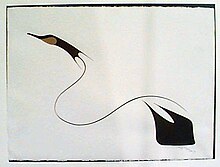Benjamin Chee Chee: Difference between revisions
No edit summary |
Rescuing 1 sources and tagging 0 as dead. #IABot (v1.2.6) |
||
| Line 73: | Line 73: | ||
== External links == |
== External links == |
||
* [http://www.findagrave.com/cgi-bin/fg.cgi?page=sh&GRid=11558613& Benjamin Chee Chee on-line cemetery] |
* [http://www.findagrave.com/cgi-bin/fg.cgi?page=sh&GRid=11558613& Benjamin Chee Chee on-line cemetery] |
||
* [http://www.whetung.com/chee.html Benjamin Chee Chee cards] |
* [https://web.archive.org/web/20070102062704/http://www.whetung.com:80/chee.html Benjamin Chee Chee cards] |
||
* [http://www.sa-cinn.com/cheechee.htm Benjamin Chee Chee art] |
* [http://www.sa-cinn.com/cheechee.htm Benjamin Chee Chee art] |
||
* [http://www.sg-chem.net/art/native-canadian-art.php Benjamin Chee Chee art sold recently at auctions] |
* [http://www.sg-chem.net/art/native-canadian-art.php Benjamin Chee Chee art sold recently at auctions] |
||
Revision as of 00:07, 31 October 2016
Benjamin Chee Chee | |
|---|---|
 | |
| Born | March 26, 1944 |
| Died | March 14, 1977 (aged 32) |
| Nationality | Canadian |
| Education | Self-taught |
| Known for | Painting |
| Movement | Woodland School of Art |
Benjamin Chee Chee, (born Kenneth Thomas Benjamin) was a Canadian artist of Ojibwa descent.[1] He was born at Temagami, Ontario on 26 March 1944; and died in Ottawa on 14 March 1977.[1] His early life was troubled and he lost track of his mother, who he spent many years searching for. He moved to Montreal in 1965 where he developed his love of drawing, and moved back to Ottawa in 1973.

Chee Chee's first exhibition was held in 1973 at the University of Ottawa.[2] Soon after he gained fame as he developed his unique style of clear graceful lines with minimal colour of birds and animals giving sense to emotion and movement. Though his art featured a great deal of iconography often used by Canadian First Nations artists, Chee Chee had denied his art had symbolic meaning. He instead referred to the animals featured in his art as "creatures of the present". He also specifically referred to himself to an Ojibway artist, as opposed to allowing himself to be categorized under the broader net of simply an "Indian" artist.
After finally finding his mother and achieving success as an artist, he committed suicide in an Ottawa jail. Benjamin Chee Chee was buried in Notre Dame Cemetery in Ottawa, Ontario.[1] His work has been exhibited posthumously throughout Canada.
References
Sources
- Evans, Alvin L. (2004). Chee Chee: A Study of Aboriginal Suicide. McGill-Queens University Press. ISBN 978-0773526877.
{{cite book}}: Invalid|ref=harv(help) - Lerner, Loren R.; Williamson, Mary F. (1991). Art and Architecture in Canada. U Toronto Press. ISBN 978-0802058560.
{{cite book}}: Invalid|ref=harv(help) - Matuz, Roger (1998). St. James Guide to Native North American Artists. The University of Michigan. ISBN 978-1558622210.
{{cite book}}: Invalid|ref=harv(help) - "Native artist Benjamin Chee Chee". www.native-art-in-canada.com. 2006. Retrieved 13 April 2016.
External links
- Use dmy dates from January 2011
- Ojibwe people
- 1944 births
- 1977 deaths
- First Nations painters
- Artists who committed suicide
- Suicides by hanging in Ontario
- Canadian people who died in prison custody
- Prisoners who died in Canadian detention
- People who committed suicide in prison custody
- Artists from Ontario
- 20th-century Canadian painters
- Woodlands style
